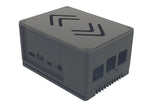My ARM fleet has grown over the years, but is as yet no Armada. What began with a single Raspberry Pi Model B+ and soon grew with Banana Pro and a BeagleBone Black to no less than four running ARM cores, was in the end of the 32-bit era a cluster-like stack of SBCs consisting of Raspberry Pi's 2, 3 and 4 (two examples of each), so 24 cores running, with the afore mentioned Raspberry Pi Model B+, Banana Pro and BeagleBone Black forming the reserve, together with a Cubieboard 4 that went out with a bang! due to overheating -and I still hope to be able to revive it -I hope it was the card or the PSU that went bang!, I can't find anything on the board. I must have a PSU that's able to deliver 5V-4A somewhere....
Then the Raspberry foundation brought out their 8GB Raspberry Pi 4 Model, together with a 64-bit OS. So I went out and bought one, and I bought a 64-bit Odroid-N2+ as well -after my experiment with a 32-bit Odroid-XU4 went well.
My 32-bit fleet now consists of two Raspberry Pi 2 Model B, two Raspberry Pi 3 Model B and an Odroid-XU4 (still 24 cores running, but a tad faster) with the Cubieboard 4 (8 cores) still in reserve. In the event the Cubieboard 4 is raised from the grave the Raspberry Pi 2's go to the reserve, as I expect the performance of the Cubieboard 4 to be about the same as that of the Odroid-XU4 -slightly less than four times that of a Raspberry Pi 2, two times that of a Raspberry Pi 3.
The 64-bit fleet is in the build-up phase and will consist of three Raspberry Pi 4 Model B and two Odroid-N2+ (one with Android, the other with Linux), also 24 cores running.









 Reply With Quote
Reply With Quote


